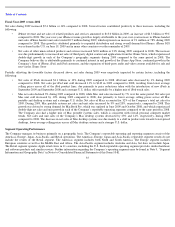Apple 2010 Annual Report Download - page 46
Download and view the complete annual report
Please find page 46 of the 2010 Apple annual report below. You can navigate through the pages in the report by either clicking on the pages listed below, or by using the keyword search tool below to find specific information within the annual report.
Table of Contents
movements in either foreign exchange or interest rates. In addition, the timing of the accounting for recognition of gains and losses related to
mark-to-
market instruments for any given period may not coincide with the timing of gains and losses related to the underlying economic
exposures and, therefore, may adversely affect the Company’s financial condition and operating results.
Interest Rate Risk
While the Company is exposed to interest rate fluctuations in many of the world’s leading industrialized countries, the Company’
s interest
income and expense is most sensitive to fluctuations in the general level of U.S. interest rates. As such, changes in U.S. interest rates affect the
interest earned on the Company’
s cash, cash equivalents and marketable securities, the fair value of those investments, as well as costs
associated with foreign currency hedges.
The Company’
s investment policy and strategy are focused on preservation of capital and supporting the liquidity requirements of the Company.
A portion of the Company’s cash is managed by external managers within the guidelines of the Company’
s investment policy and to objective
market benchmarks. The Company’s internal portfolio is benchmarked against external manager performance.
The Company’s exposure to market risk for changes in interest rates relates primarily to the Company’
s investment portfolio. The Company
typically invests in highly rated securities and its policy generally limits the amount of credit exposure to any one issuer. The Company’
s
investment policy requires investments to be investment grade, primarily rated single-
A or better, with the objective of minimizing the potential
risk of principal loss. All highly liquid investments with initial maturities of three months or less at the date of purchase are classified as cash
equivalents. The Company classifies its marketable securities as either short-term or long-term based on each instrument’
s underlying
contractual maturity date. All short-term marketable securities have maturities less than 12 months, while all long-
term marketable securities
have maturities ranging from one to five years. The Company may sell its investments prior to their stated maturities for strategic purposes, in
anticipation of credit deterioration, or for duration management. The Company recognized no significant net gains or losses during 2010, 2009
and 2008 related to such sales.
To provide a meaningful assessment of the interest rate risk associated with the Company’
s investment portfolio, the Company performed a
sensitivity analysis to determine the impact a change in interest rates would have on the value of the investment portfolio assuming a 100 basis
point parallel shift in the yield curve. Based on investment positions as of September 25, 2010, a hypothetical 100 basis point increase in interest
rates across all maturities would result in a $477 million incremental decline in the fair market value of the portfolio. As of September 26, 2009,
a similar 100 basis point shift in the yield curve would have resulted in a $176 million incremental decline in the fair market value of the
portfolio. Such losses would only be realized if the Company sold the investments prior to maturity.
Foreign Currency Risk
In general, the Company is a net receiver of currencies other than the U.S. dollar. Accordingly, changes in exchange rates, and in particular a
strengthening of the U.S. dollar, will negatively affect the Company’
s net sales and gross margins as expressed in U.S. dollars. There is also a
risk that the Company will have to adjust local currency product pricing due to competitive pressures when there has been significant volatility
in foreign currency exchange rates.
The Company may enter into foreign currency forward and option contracts with financial institutions to protect against foreign exchange risks
associated with certain existing assets and liabilities, certain firmly committed transactions, forecasted future cash flows, and net investments in
foreign subsidiaries. Generally, the Company’
s practice is to hedge a majority of its material foreign exchange exposures, typically for three to
six months.
43
























